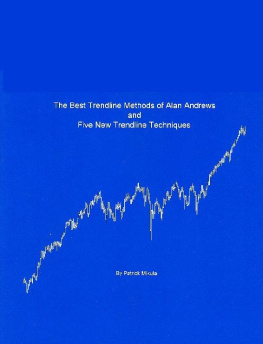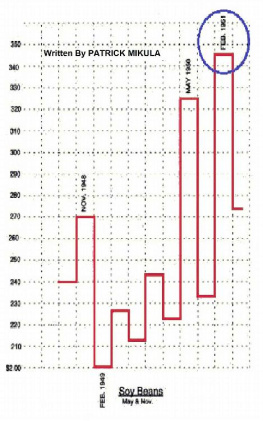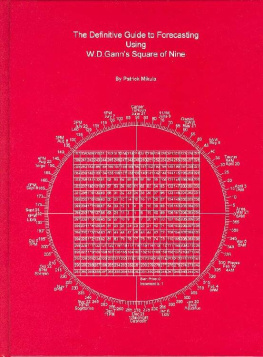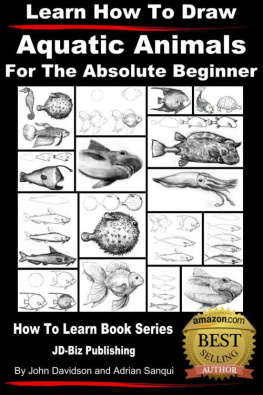Table of Contents
The Best Trendline Methods of Alan Andrews and Five New Trendline Techniques
SECTION 1: The Best Trendline Methods of Alan Andrews
SECTION 2: Five New Trendline Techniques
SECTION 3: eBook Bonus Chapter
Legal Disclaimer and Copyright

Written by: Patrick Mikula CTA
Mikula Forecasting Company
P.O. Box 152672
Austin, TX 78715-2672
USA
http://www.mikulaforecasting.com/
The Best Trendline Methods of Alan Andrews and Five New Trendline Techniques
Copyright:
eBook Revised Version:
Copyright 2012 by Patrick Mikula All Rights Reserved
ISBN 978-0-9650518-5-9
eBook Version:
Copyright 2010 by Patrick Mikula All Rights Reserved
Original Softcover version
Copyright 2002 by Patrick Mikula All Rights Reserved
First Edition: Second Printing
ISBN 0-9650518-3-8
Copyright Notice:
No part of this book may be reproduced without written permission from the publisher. No part of this book may be reproduced, stored in a retrieval system, or transmitted in any form or by any means, photocopying, electronic, mechanical, or otherwise, without the prior written permission of the publisher.
Legal Disclaimer:
Important Notice:
No claim is made that the trading methods or ideas in this book will result in profits and will not result in losses. The contents of this book are not guaranteed to produce profits. Commodity futures or stock trading is a risky business and may not be suitable for all recipients of this book. Although the financial correlations contained in this book have been reliable in the past there is no guarantee by the book's author or distributors that they will work in the future. Each trader is responsible for his/her own actions in the markets, if any. The contents of this book are not, and should not be considered as an offer to buy or sell any commodity or futures contract or stock. Purchase of this book constitutes your agreement to this disclaimer and exempts its author and distributors from any liability or litigation.
End
Introduction
I am fortunate to have been involved with trading before computers completely took over technical analysis and I have read many trading books written between 1950 to 1980. There is a much greater discussion of trendline methods in those older books than there is in trading books of today. My first encounter with a reference to Alan Andrews was in the 1986 book, Technical Analysis of the Futures Markets, by John Murphy. I have been researching Alan Andrews trendline methods ever since and present my findings here. In my book, Alan Andrews will be referred to simply as Andrews.
In my consulting work as a Commodity Trading Advisor (CTA) I encountered several people who attended the Andrews Action Reaction seminar. This provided me the opportunity to examine Andrews original material but more importantly, it allowed me to converse with traders who have used Andrews trendline methods for many years.
In his seminars, Andrews said his trendline methods were based on the work of Roger Babson. In the 1930s, Roger Babson was publicly credited with forecasting the crash of 1929 more accurately than any other person. The exact nature of what Roger Babson showed Andrews no one can know. My research leads me to believe Roger Babson gave Andrews the concept of financial action and reaction. Then Andrews developed his trendline methods based on this idea.
The methods used by Roger Babson and Andrews may have been based on the same theory of action reaction but the actual methods are very different. Roger Babson used a method which measured how far the price moved above or below a line drawn through the center of previous price swings. This allowed Babson to calculate the average distance above or below the center line that a price swing should move before it turns the other direction. It is believed that Babson used this method to make a fortune in the markets by identifying when markets were over extended either upward or downward. This is also believed to be the method he used in 1929 to give many public warnings that the stock market was greatly over extended and a large decline was coming. When the 1929 crash finally came, Babson was heralded as a genius.
The methods used by Andrews appear to be based on this same idea of the price moving around a center line but are different from the methods used by Babson. The Babson methods are for long term stock market and economic analysis, while the Andrews methods are for short term trading. The end result for Babson and Andrews was similar, because it is reported that Andrews also made a very large amount of money trading. The traders with whom I have talked, who attended the Andrews seminars, indicated that Andrews made well over a million dollars trading.
The biographical information on Andrews of interest from a traders perspective is rather meager. Andrews did not become involved with sharing his trendline methods and his ideas on trading until after he retired. I have not encountered any investors who dealt with Andrews for trading purposes before the mid 1960s. The documentation from his Action Reaction Course and his seminars is dated in the 1960s and 1970s. This 20 year period seems to be when Andrews became active as a financial educator and trader.
This book is written in two sections. The first section presents the material which can be directly attributed to Andrews. I refrained from inserting my opinions and ideas into the first section and included only Andrews methods. In the greater body of Andrews work, there are ideas and methods which were suggested by his students. Andrews encouraged his students to share their ideas. This material has been left out of the book because the methods suggested by Andrews students are not the methods Andrews used to make a fortune in the markets.
The second section of this book deals with new trendline developments made at Mikula Forecasting Company. In this way, the reader can separate clearly the original Andrews ideas from the new ideas. After becoming a CTA, I was asked to develop a trading method for the Eurodollar futures, which I did. Since that time developing trading or prediction models has become the largest part of my business as a CTA. In the second section of this book are five new ways to apply trendline methods.
There was a time when I thought computers would replace all the old trading methods. After years of watching advanced computer models come and go I no longer believe that. After you read this book I hope you will agree that trendline methods, both old and new, still have great financial value to traders. The computer is a powerful tool for doing repetitive work and time consuming tasks but nothing replaces simple methods which work and trading experience.
End
Bar Charts and Pivots
In this book we will use the standard financial bar chart to present the trendline methods. The chart seen below is a bar chart. The price scale is on the left side. The time scale is across the bottom. Each vertical line is an individual price bar. In this book we will often make reference to a price pivot. A pivot is a point where the price bars change direction. On the chart below there is a label Top Pivot and a label Bottom Pivot. These identify simple examples of pivots.

The picture below shows an individual price bar. The bar has an opening tick mark on the left and the closing tick mark on the right side. The high and low price are used to create the vertical bar.











